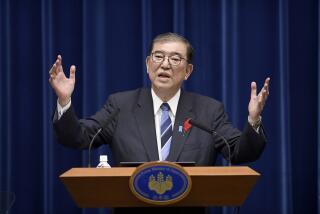Grand Kabuki at Nagatacho
- Share via
When Westerners see signs of fundamental change in Japan, they often turn out to be disappointed at the glacial pace that follows. True, Japanese voters this week gave a resounding hai , or yes, to major political change. But they granted that mandate to no particular party. Thus the stage is set for a grand Kabuki at Nagatacho, the center of government, in Tokyo. Much of the ensuing drama will be marked by political uncertainty as parties jostle to build coalitions to shape a new government. Another election is likely soon. That too might prove inconclusive.
With the shattering of the Liberal Democratic Party’s one-party rule, Japan is moving toward becoming a more democratic nation. But change will be slow, with no immediate impact on policy. Indeed, a weak Tokyo government will probably have little appetite for bold or controversial initiatives, especially when it comes to trade.
The LDP is still the largest political party and fared better than expected. But public revulsion against the party’s long unrepentant, greasy money politics cost the LDP its majority in the lower house of Parliament for the first time in 38 years.
Voters sought to clean out the corruption. The result: the emergence of three conservative parties--Japan New Party, the Renewal Party and New Party Harbinger. The big losers were the left-leaning Socialists. And, in a surprisingly independent move, Kiichi Miyazawa unexpectedly refused to resign as prime minister.
The politicians may be in the spotlight now, but much of the power in Japan rests with bureaucrats and big business, a troika dubbed the “iron triangle.” Working together, they have forged a Japan Inc. that puts producer interests well ahead of those of consumers, who traditionally face high prices for food and homes. Now Japanese voters say “yes” to change--to having more democracy, choice and voice. That is a notable departure from a Japan that too often seems to say hai but means something else.
More to Read
Sign up for Essential California
The most important California stories and recommendations in your inbox every morning.
You may occasionally receive promotional content from the Los Angeles Times.












